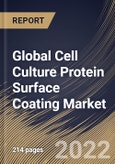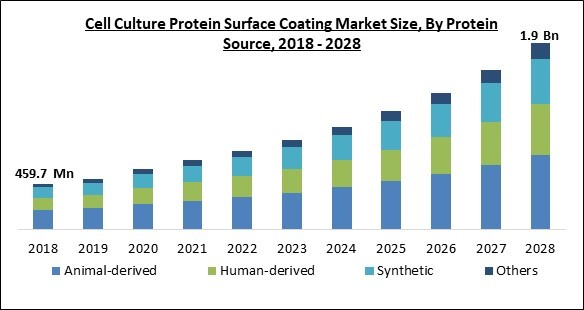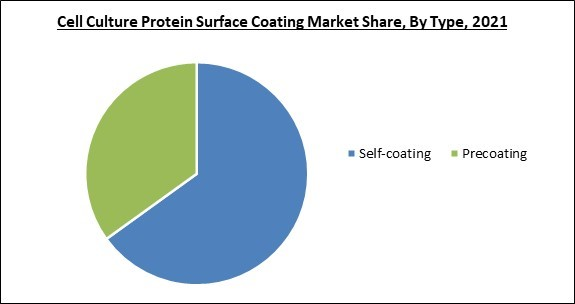The Global Cell Culture Protein Surface Coating Market size is expected to reach $1.9 billion by 2028, rising at a market growth of 15.5% CAGR during the forecast period.
Cell culture protein surface coating is a process, which aims to improve the growth and cell adhesion of in vitro cell culture. Protein-coated cell culture tools provide a three-dimensional microenvironment for optimal adhesion and proliferation of cells. The optimization of the cell culture environment permits the growth, function, and survival of cells in a manner that is realistic and representative.
Protein surface coating of cell culture comprises coating the cell culture surface using extracellular matrix and protein components to enhance the proliferation and adherence of cells in vitro. Corning is one of the most traditional approaches for businesses specializing in cell-culture surface technology, with a long history of creating innovative surfaces with enhanced capabilities. 3D cell culture is the technique of cultivating biological cells in a controlled environment where they can interact with neighboring cells in every dimension.
Cell culture is also known as tissue culture and is the process of growing cells under controlled conditions, typically outside their native habitat. These cells are used to create model systems for research, the investigation of cellular structure and function, stem cell research, drug development, and genetic engineering.
The market research report covers the analysis of key stakeholders of the market. Key companies profiled in the report include Thermo Fisher Scientific, Corning, Inc., Merck Millipore (Merck Group), Promega Corp., Sartorius Stedim Biotech S.A. (Sartorius AG), Greiner Bio-One International GmbH, PerkinElmer, Inc., BioVision, Inc., Bio-Techne Corporation and Viogene BioTek Corp.
Cell culture protein surface coating is a process, which aims to improve the growth and cell adhesion of in vitro cell culture. Protein-coated cell culture tools provide a three-dimensional microenvironment for optimal adhesion and proliferation of cells. The optimization of the cell culture environment permits the growth, function, and survival of cells in a manner that is realistic and representative.
Protein surface coating of cell culture comprises coating the cell culture surface using extracellular matrix and protein components to enhance the proliferation and adherence of cells in vitro. Corning is one of the most traditional approaches for businesses specializing in cell-culture surface technology, with a long history of creating innovative surfaces with enhanced capabilities. 3D cell culture is the technique of cultivating biological cells in a controlled environment where they can interact with neighboring cells in every dimension.
Cell culture is also known as tissue culture and is the process of growing cells under controlled conditions, typically outside their native habitat. These cells are used to create model systems for research, the investigation of cellular structure and function, stem cell research, drug development, and genetic engineering.
COVID-19 Impact Analysis
The COVID-19 pandemic caused major damage to several economies all over the world. A number of businesses all over the world were significantly hampered due to the emergence of the pandemic. However, the cell culture protein surface coating market was positively impacted due to the outbreak. Stem cells have emerged as a potential treatment for a variety of conditions, including heart failure, osteoarthritis, and eye illnesses that can also be a side-effect of the COVID-19 infection. Therefore, the growth of the cell culture protein surface coating market was bolstered during the COVID-19 pandemic.Market Growth Factors
Increasing Focus of Biotechnology and Life Science Companies to Leverage Advanced Stem Cell Research Approaches
Stem-cell research is the study of the qualities and possible applications of stem cells obtained from animals. Stem cells are the source of all bodily tissues and comprehending their features facilitates comprehension of the development and homeostasis of the healthy and diseased body. These cells maintain a constant equilibrium between differentiation and self-renewal. Complying with the stem cell biology information and the most recent technological advances, stem cell culture conditions are crucial and must be continuously optimized.An Upsurge in The Adoption Of 3d Cell Culture in Recent Years
In drug discovery and tissue engineering, interest in three-dimensional (3D) cell culture techniques have increased due to their obvious advantages in giving more physiologically relevant data and more predictive statistics for in vivo studies. A rising number of studies and research indicate that in contrast to the 2D culture system, 3D cell culture systems more effectively replicate the actual environment in which cells live in tissues.Marketing Restraining Factor:
The Dearth of Skilled Professionals to Operate Instruments and Procedures
The cell culture protein surface coating method is a very efficient and advanced approach in the healthcare and life science sector. However, there is a lack of skills and expertise in the industry in order to execute equipment and processes. In consideration of technological breakthroughs and product development in recent years, the industry has been impacted by a lack of qualified personnel to operate complicated equipment, such as flow cytometers or multi-mode readers.Type Outlook
Based on Coating Type, the Cell Culture Protein Surface Coating Market is bifurcated into Self-coating and Precoating. In 2021, the precoating segment garnered a significant revenue share of the cell culture protein surface coating market. Precoated culture goods offer numerous benefits, such as being ready-to-use, saving time, delivering consistent quality, and enhancing isolation and cultivation. Consequently, the appeal of precoated cultural goods is growing.Protein Source Outlook
By Protein Source, the Cell Culture Protein Surface Coating Market is segmented into Animal-derived, Human-derived, Synthetic, and Plant-derived. In 2021, the synthetic segment registered a promising revenue share of the cell culture protein surface coating market. The rising demand for animal-free components is a major contributor to the expansion of this market segment. In recent years, the trend of veganism has emerged and is now spreading significantly all over the world.Regional Outlook
Region-Wise, the Cell Culture Protein Surface Coating Market is analyzed across North America, Europe, Asia-Pacific, and LAMEA. In 2021, North America accounted for the highest revenue share of the cell culture protein surface coating market. The highly developed healthcare and research infrastructure as well as the region's emphasis on drug discovery have propelled the growth of the regional cell culture protein surface coating market.The market research report covers the analysis of key stakeholders of the market. Key companies profiled in the report include Thermo Fisher Scientific, Corning, Inc., Merck Millipore (Merck Group), Promega Corp., Sartorius Stedim Biotech S.A. (Sartorius AG), Greiner Bio-One International GmbH, PerkinElmer, Inc., BioVision, Inc., Bio-Techne Corporation and Viogene BioTek Corp.
Scope of the Study
By Type
- Self-coating
- Precoating
- Multiwall/microwell Plates
- Petri Dishes
- Flasks
- Slides
- Cover Slips
By Protein Source
- Animal-derived
- Human-derived
- Synthetic
- Others
By Geography
- North America
- US
- Canada
- Mexico
- Rest of North America
- Europe
- Germany
- UK
- France
- Russia
- Spain
- Italy
- Rest of Europe
- Asia Pacific
- China
- Japan
- India
- South Korea
- Singapore
- Malaysia
- Rest of Asia Pacific
- LAMEA
- Brazil
- Argentina
- UAE
- Saudi Arabia
- South Africa
- Nigeria
- Rest of LAMEA
Key Market Players
List of Companies Profiled in the Report:
- Thermo Fisher Scientific
- Corning, Inc.
- Merck Millipore (Merck Group)
- Promega Corp.
- Sartorius Stedim Biotech S.A. (Sartorius AG)
- Greiner Bio-One International GmbH
- PerkinElmer, Inc.
- BioVision, Inc.
- Bio-Techne Corporation
- Viogene BioTek Corp.
Unique Offerings
- Exhaustive coverage
- The highest number of market tables and figures
- Subscription-based model available
- Guaranteed best price
- Assured post sales research support with 10% customization free
Table of Contents
Chapter 1. Market Scope & Methodology
Chapter 2. Market Overview
Chapter 3. Global Cell Culture Protein Surface Coating Market by Type
Chapter 4. Global Cell Culture Protein Surface Coating Market by Protein Source
Chapter 5. Global Cell Culture Protein Surface Coating Market by Region
Chapter 6. Company Profiles
Companies Mentioned
- Thermo Fisher Scientific
- Corning, Inc.
- Merck Millipore (Merck Group)
- Promega Corp.
- Sartorius Stedim Biotech S.A. (Sartorius AG)
- Greiner Bio-One International GmbH
- PerkinElmer, Inc.
- BioVision, Inc.
- Bio-Techne Corporation
- Viogene BioTek Corp.
Methodology

LOADING...
Table Information
| Report Attribute | Details |
|---|---|
| No. of Pages | 214 |
| Published | October 2022 |
| Forecast Period | 2021 - 2028 |
| Estimated Market Value ( USD | $ 699 Million |
| Forecasted Market Value ( USD | $ 1881 Million |
| Compound Annual Growth Rate | 15.5% |
| Regions Covered | Global |
| No. of Companies Mentioned | 10 |










